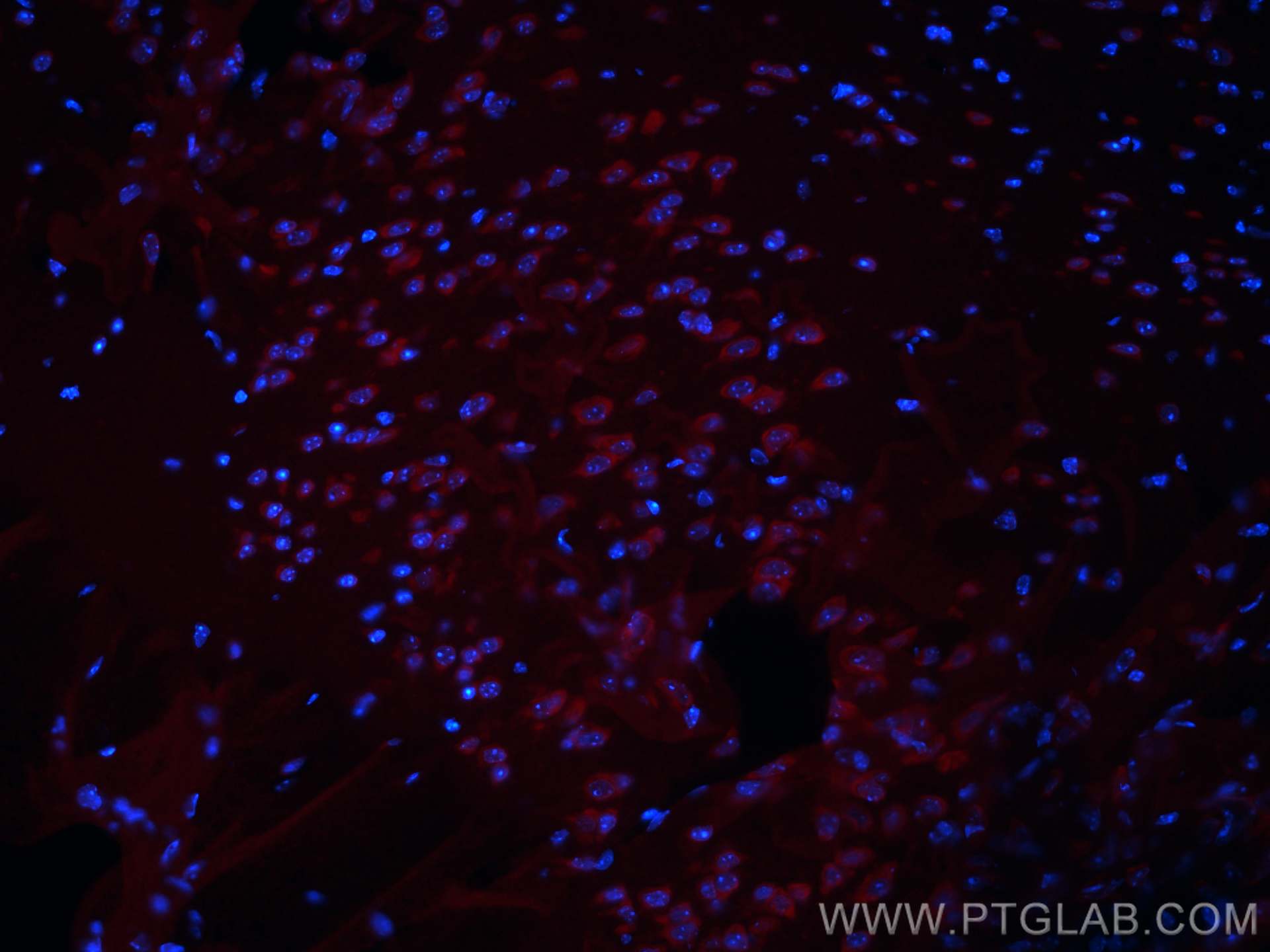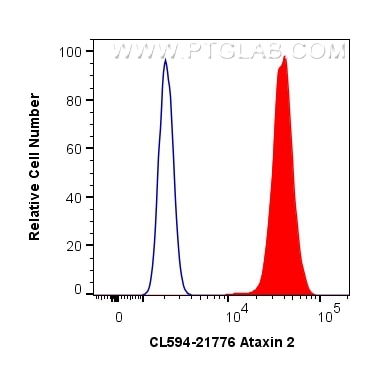- Phare
- Validé par KD/KO
Anticorps Polyclonal de lapin anti-Ataxin 2
Ataxin 2 Polyclonal Antibody for IF-P, FC (Intra)
Hôte / Isotype
Lapin / IgG
Réactivité testée
Humain, rat, souris
Applications
IF-P, FC (Intra)
Conjugaison
CoraLite®594 Fluorescent Dye
N° de cat : CL594-21776
Synonymes
Galerie de données de validation
Applications testées
| Résultats positifs en IF-P | tissu cérébral de souris, |
| Résultats positifs en FC (Intra) | cellules HeLa, |
Dilution recommandée
| Application | Dilution |
|---|---|
| Immunofluorescence (IF)-P | IF-P : 1:50-1:500 |
| Flow Cytometry (FC) (INTRA) | FC (INTRA) : 0.40 ug per 10^6 cells in a 100 µl suspension |
| It is recommended that this reagent should be titrated in each testing system to obtain optimal results. | |
| Sample-dependent, check data in validation data gallery | |
Informations sur le produit
CL594-21776 cible Ataxin 2 dans les applications de IF-P, FC (Intra) et montre une réactivité avec des échantillons Humain, rat, souris
| Réactivité | Humain, rat, souris |
| Hôte / Isotype | Lapin / IgG |
| Clonalité | Polyclonal |
| Type | Anticorps |
| Immunogène | Ataxin 2 Protéine recombinante Ag16470 |
| Nom complet | ataxin 2 |
| Masse moléculaire calculée | 1313 aa, 140 kDa |
| Poids moléculaire observé | 140-150 kDa |
| Numéro d’acquisition GenBank | BC114546 |
| Symbole du gène | ATXN2 |
| Identification du gène (NCBI) | 6311 |
| Conjugaison | CoraLite®594 Fluorescent Dye |
| Excitation/Emission maxima wavelengths | 588 nm / 604 nm |
| Forme | Liquide |
| Méthode de purification | Purification par affinité contre l'antigène |
| Tampon de stockage | PBS with 50% glycerol, 0.05% Proclin300, 0.5% BSA |
| Conditions de stockage | Stocker à -20 °C. Éviter toute exposition à la lumière. Stable pendant un an après l'expédition. L'aliquotage n'est pas nécessaire pour le stockage à -20oC Les 20ul contiennent 0,1% de BSA. |
Informations générales
Background
ATXN2 (Ataxin-2) is a eukaryotic RNA‐binding protein that is conserved across species. It contains two LSm domains (RNA binding), a PAM2 motif (association with poly(A)-binding protein), and an N-terminal polyglutamine tract (PMID: 25027299). Ataxin-2 plays crucial roles at different stages of the regulation of posttranslational gene expression. ATXN2 is also directly implicated in the regulation of neural function by influencing specific molecular and cellular pathways. Genetic expansion of a poly‐glutamine tract in human ATXN2 has been linked to several neurodegenerative diseases, where it most likely acts through gain‐of‐function effects.
What is the molecular weight of ATXN2?
The molecular weight varies from 12 to 140 kDa, depending on the isoform.
What are the isoforms of ATXN2?
ATXN2 has many isoforms, which differ significantly in length and domain composition.
What is the subcellular localization of ATXN2?
According to siRNA-based experiments, it is localized in the cytoplasmic compartment of normal cells, where it mostly associates with the Golgi apparatus and stress granules (PMID: 22508507).
What is the tissue specificity of ATXN2?
ATXN2 protein has been detected in various tissues; however, it is most highly expressed and studied in CNS. Significant amounts of this protein can also be detected in the liver and gallbladder.
What is the molecular function of ATXN2?
Ataxin-2 is involved in regulating various steps of mRNA translation, including poly‐A tailing, RNA stabilization, microRNA‐dependent gene silencing, and translational activation. All those functions are linked to its interactions with the poly(A)-binding protein. Ataxin-2 is involved in the formation of stress granules and P-bodies. Furthermore, genetic models of ATXN2 loss‐of‐function have underlined the importance of ATXN2 in mTOR signaling and cellular metabolism, which are all crucial for neural homeostasis (PMID: 29869836).
What is ATXN2's involvement in disease?
The N-terminal region of ATXN2 normally contains a polyQ stretch of 14-31 residues that can be expanded in the pathogenic state to 32-200 residues. Intermediate length expansions of this tract increase susceptibility to amyotrophic lateral sclerosis (ALS or Lou Gehrig's disease) (PMID: 20740007). Long expansions of this tract result in spinocerebellar ataxia-2 (SCA2), an autosomal dominantly inherited, neurodegenerative disorder (PMID: 29427103). Genome-wide association studies indicate that loss-of-function mutations in this gene are associated with susceptibility to type I diabetes, obesity, and hypertension.
Protocole
| Product Specific Protocols | |
|---|---|
| IF protocol for CL594 Ataxin 2 antibody CL594-21776 | Download protocol |
| FC protocol for CL594 Ataxin 2 antibody CL594-21776 | Download protocol |
| Standard Protocols | |
|---|---|
| Click here to view our Standard Protocols |



